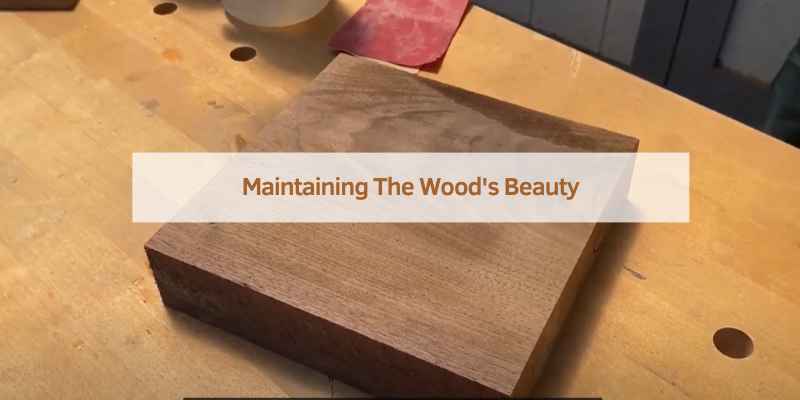To make wood grain stand out, use wood conditioner before staining. Apply multiple thin coats for depth.
Enhancing the beauty of wood grain can greatly elevate the overall look of your woodworking projects. By following a few simple steps and techniques, you can make the natural patterns and textures of the wood truly stand out. One effective method is to use a wood conditioner before applying the stain, which helps the wood absorb the stain more evenly and vividly.
Additionally, applying multiple thin coats of stain instead of one thick coat can create depth and richness in the wood grain, enhancing its visual appeal. In this blog post, we will explore various tips and tricks to help you make the wood grain stand out in your projects.
Introduction To Wood Grain Enhancement
Wood grain enhancement is a crucial process for bringing out the natural beauty of wood. By highlighting the unique patterns and textures of the grain, you can create stunning visual effects that add depth and character to your woodworking projects. In this guide, we will explore the art of enhancing wood grain and the techniques that can be used to make it stand out.
The Beauty Of Wood Grain
Wood grain is a testament to the organic and natural beauty of wood. It consists of intricate patterns, lines, and textures that are formed by the growth rings and cellular structure of the tree. Each type of wood has its own distinct grain pattern, ranging from the bold and pronounced to the subtle and delicate. The beauty of wood grain lies in its uniqueness and the way it adds visual interest to wooden surfaces.
Importance Of Grain Highlighting
Highlighting the wood grain is essential for showcasing the inherent beauty of the wood. By accentuating the natural patterns and textures, you can elevate the overall appearance of your woodworking projects. Whether it’s furniture, flooring, or decorative accents, bringing out the wood grain can transform ordinary pieces into extraordinary works of art.

Choosing The Right Wood Species
Characteristics Of Different Woods
Wood species vary in their grain patterns, color, and hardness. Some woods have a more pronounced grain, while others have a subtler appearance. It’s important to consider these factors when choosing the right wood for your project.
Best Woods For Prominent Grain
When aiming to make wood grain stand out, opting for species with bold and distinctive grain patterns is essential. Woods like oak, walnut, and mahogany are renowned for their strong and visually appealing grain. These species are excellent choices for projects where showcasing the natural beauty of wood grain is a priority.
Sanding Techniques For Clarity
Enhance the natural beauty of wood grain by mastering the art of sanding techniques. Discover how to make wood grain stand out with our expert tips and achieve clarity in your woodworking projects.
Grain Exposure Through Sanding
Sanding is a crucial part of bringing out the beauty of wood grain. Proper sanding techniques can help expose the natural beauty of the wood grain. To achieve this, you’ll need to start with the right grit sandpaper and work your way up. Begin with a coarse grit, such as 60 or 80 grit, to remove any rough spots or inconsistencies. From there, move on to a finer grit, such as 120 or 150 grit, to smooth out the surface and prepare it for finishing.
Sanding Tips For Optimal Results
Here are some sanding tips that can help you achieve optimal results when trying to make wood grain stand out:
- Always sand with the grain of the wood, not against it.
- Use a sanding block or sanding pad to ensure even pressure and prevent uneven sanding.
- Change sandpaper frequently to avoid clogging and ensure optimal sanding performance.
- Use a vacuum or dust collector to prevent sawdust buildup, which can interfere with sanding and finishing.
- Wipe down the surface with a tack cloth after sanding to remove any remaining dust or debris.
Remember, sanding is a process that requires patience and attention to detail. Take your time and use the right tools and techniques to achieve the best results.
In conclusion, sanding is a critical step in making wood grain stand out. By using the right sandpaper and sanding techniques, you can achieve optimal results and bring out the natural beauty of the wood. With these tips and tricks, you’ll be able to create stunning woodworking projects that showcase the beauty and character of the wood.
Applying The Perfect Stain
When it comes to making wood grain stand out, applying the perfect stain is key. Achieving a rich, vibrant wood finish can enhance the beauty of any project.
Selecting A Stain
Choose a stain that complements the natural color and grain of the wood. Consider the type of wood and desired finish before selecting a stain.
Techniques For Even Application
- Use a clean brush or cloth for smooth application.
- Apply the stain in the direction of the wood grain.
- Wipe off excess stain for a consistent finish.
Sealing For Protection And Enhancement
To make the wood grain stand out, sealing is necessary for both protection and enhancement. Applying a sealant helps to protect the wood from moisture and other elements that can damage it, while also enhancing the natural beauty of the wood by making the grain more pronounced.
Sealing for Protection and Enhancement is a crucial step in making wood grain stand out. By sealing the wood, you not only protect it from moisture and other environmental factors, but you also enhance its natural beauty by bringing out the grain patterns. In this article, we will discuss the different types of sealers available and the application methods for enhanced grain.
Types Of Sealers
There are two main types of sealers: film-forming and penetrating. Film-forming sealers create a protective layer on top of the wood, while penetrating sealers soak into the wood fibers.
Film-forming sealers, such as polyurethane and varnish, are great for high-traffic areas and outdoor furniture. They are durable and long-lasting but can sometimes hide the natural grain patterns.
Penetrating sealers, such as oils and wax, are ideal for indoor furniture and accent pieces. They enhance the natural grain patterns and provide a more natural look and feel. However, they may not be as durable as film-forming sealers and may require more frequent reapplication.
Application Methods For Enhanced Grain
To enhance the wood grain, you can use several application methods, including staining, sanding, and brushing.
Staining is a popular technique that adds color to the wood while still allowing the grain patterns to show through. You can choose from a variety of stain colors to achieve the desired effect.
Sanding is another technique that can enhance the wood grain. By sanding the wood, you remove any rough spots or imperfections, revealing the natural beauty of the wood grain.
Brushing is a technique used with penetrating sealers to enhance the grain patterns. By brushing the sealer into the wood, you can highlight the natural patterns and create a unique look.
In conclusion, sealing for protection and enhancement is an essential step in making wood grain stand out. By choosing the right sealer and application method, you can enhance the natural beauty of the wood and protect it for years to come.
Using Grain Fillers To Your Advantage
Enhance the beauty of wood grain by utilizing grain fillers effectively. Achieve a standout finish and smooth surface by filling the grain pores before staining or painting. Elevate your woodworking projects with this simple yet impactful technique.
When it comes to achieving a beautiful wood finish, one crucial aspect is making the wood grain stand out. Using grain fillers is a technique that can help enhance the appearance of wood by filling in the pores and gaps in the grain, resulting in a smoother and more consistent surface. This not only improves the overall look of the wood but also ensures a better adhesion of subsequent finishes.
When To Use Grain Fillers
Grain fillers are particularly beneficial when working with open-pored woods such as oak, mahogany, or ash. These woods have visible pores that can detract from the desired smooth and polished finish. By applying grain fillers, you can fill in these pores and create a more even surface, allowing the wood grain to stand out prominently.
Application Techniques For Fillers
When applying grain fillers, it’s essential to follow proper techniques to achieve the best results. Here are some application tips:
- Start by sanding the wood to a smooth surface, ensuring all dust and debris are removed.
- Choose a suitable grain filler that matches the color of your wood or opt for a transparent filler if you want to maintain the natural color.
- Apply the filler using a putty knife or a plastic spatula, working it into the wood grain in a circular motion.
- Make sure to fill in all the pores and gaps completely, ensuring an even distribution of the filler.
- Allow the filler to dry according to the manufacturer’s instructions, usually for about 15-30 minutes.
- After drying, use a sanding block or sandpaper to gently remove excess filler, being careful not to sand down the filled areas.
- Repeat the process if necessary until you achieve the desired smoothness and level of grain filling.
By using grain fillers effectively, you can take your wood finishing to the next level, creating a stunning and professional-looking result. Remember to always test the filler on a small inconspicuous area before applying it to the entire surface to ensure compatibility with your wood and desired outcome.
Creative Techniques For Highlighting Grain
Enhancing the wood grain in your projects is a surefire way to add depth and character to your woodworking creations. By employing various creative techniques, you can make the natural beauty of the wood grain stand out in a striking manner.
Glazing For Depth
Using glazing techniques can help amplify the natural depth of the wood grain. Apply a thin layer of glaze over the wood surface to enhance the contrast and make the grain patterns pop.
Creating Contrast With Washes
Washes are an effective way to emphasize the wood grain by creating contrast. By applying a diluted paint or stain mixture and wiping it off, you can accentuate the grain patterns for a bold and distinct look.
Maintaining The Wood’s Beauty
Preserving the natural beauty of wood grain requires regular maintenance and occasional refinishing. By following simple care routines, you can enhance the appearance and longevity of your wooden furniture and surfaces.
Regular Maintenance Tips
- Dust wood surfaces regularly to prevent buildup and maintain shine.
- Use a gentle cleaner and soft cloth to wipe down surfaces as needed.
- Avoid placing hot items directly on wood to prevent damage.
Repairing And Reapplying Finishes
Inspect wood for scratches or dull spots and repair as needed to keep the grain looking vibrant. When refinishing, clean the surface thoroughly and apply a fresh coat of finish evenly.

Frequently Asked Questions
How Can I Make Wood Grain Stand Out?
To make wood grain stand out, start by sanding the surface to remove old finish. Apply a pre-stain wood conditioner, then choose a stain that complements the wood. Apply the stain evenly and wipe off excess. Finish with a clear topcoat to protect and enhance the wood grain.
What Are Some Techniques To Enhance Wood Grain?
Techniques to enhance wood grain include using a wire brush to create a weathered look, applying a glaze to highlight the grain, and using a wood graining tool to mimic different wood species. Experiment with different techniques on scrap wood to find the look you desire.
Can I Use Color To Make Wood Grain Stand Out?
Yes, using color can enhance wood grain. Choose a stain color that contrasts with the natural wood color to make the grain pop. For a bolder statement, consider using a colored wood dye. Always test the color on a small, inconspicuous area before applying it to the entire project.
What Finishes Can Help Bring Out Wood Grain?
Finishes such as varnish, polyurethane, and lacquer can bring out wood grain. Choose a finish based on the level of durability and sheen you desire. A glossy finish can enhance the wood grain’s depth and richness, while a satin finish offers a more subtle enhancement.
Conclusion
Enhancing the wood grain in your projects can bring out its natural beauty and add a touch of elegance to any space. By following the tips mentioned in this blog post, such as choosing the right stain, using proper sanding techniques, and applying a protective finish, you can make the wood grain stand out and create stunning results.
Remember to experiment and have fun with different techniques to achieve the desired effect. Happy woodworking!


